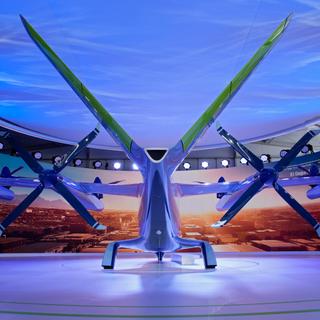


Hyundai's flying taxi takes shape
In DepthAt the Consumer Electronics Show in Las Vegas, the Korean company unveiled a vertical take-off aircraft capable of carrying four passengers. The vehicle is expected to be certified by US authorities for commercial services in 2028.
It's not quite a plane, not really a helicopter and not a drone either. The first flying taxi from Supernal, a division of South Korea's Hyundai Group, features four pairs of propellers that enable it to take off vertically before pivoting to move forward horizontally.
Belonging to the e-VTOL (Electric Vertical Take-off and Landing) category, the S-A2 wisely remained confined to the building of the Consumer Electronics Show (CES) in Las Vegas, where it was exhibited for the first time from Tuesday, January 9, to Friday, January 12.
Designed by a company that has 600 employees and is based in Washington, DC, close to the headquarters of the highly fastidious Federal Aviation Administration, the S-A2 will begin its first tests at the end of 2024 in the state of California. The aircraft is expected to be certified by the authorities for commercial service in 2028, a key step that would not only open up the vast American market but also facilitate obtaining authorization for operation in other parts of the world.
'The right product and the right market'
This air taxi can carry four passengers and a pilot at a cruising speed of close to 200 kilometers per hour and an altitude of 1,500 feet (457 meters), over a distance of between 45 and 70 kilometers, depending on the load carried.
It can also maneuver in bad weather. Its batteries – whose specifications have not been disclosed – are located at the rear of the fuselage, with its V-shaped tailfin, and can be replaced to incorporate the latest technological improvements. The cabin, with its deliberately minimalist design, is bathed in light that changes with the stages of flight.
Stellantis has teamed up with Californian start-up Archer Aviation to build its Midnight aircraft. China's XPeng presented a spectacular flying car at CES, capable of deploying propeller-equipped wings. Yet Supernal's directors promise they are not seeking to be the first to obtain authorization to fly this kind of aircraft, designed to relieve congestion in urban areas paralyzed by road traffic.
They claim they have been on a mission to create the "right product and the right market at the right time," said company president Jaiwon Shin, by designing "a safe, efficient vehicle." With this in mind, Supernal has recruited the former number two safety officer at the International Air Transport Association. Eventually, there is a plan to dispense with a pilot and transform the aircraft into a transport drone, but no deadline has been set.
Obstacles
You have 40% of this article left to read. The rest is for subscribers only.
